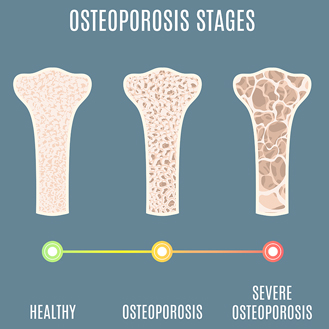
June 11, 2024
By Andriana Doliba, Drexel University College of Medicine
Osteoporosis is a common disease that results in bone weakening and increased fracture risk.1,2 Its prevalence is higher in women than men and has continued to increase in women from 2007–2008 to 2017–2018 according to the CDC.3 There are many complications, with the most feared being a hip fracture. It has been shown that in those who experience a hip fracture, there is an increased risk of death within the first 12 months post-fracture.1 So how do we prevent osteoporosis and its scary consequences? The answer lies in childhood and adolescence.2,4
Increasing peak bone mass during this time can offer lifelong fracture protection.4 Research has estimated that an increase in peak bone mass of 10% can delay the development of osteoporosis by 13 years.4,5 Sign me up! So how do we increase our peak bone mass? That’s where weight-bearing exercises come in. Exercise generates a force on the skeleton that results in mechanical strain on bone tissue. That strain is picked up by mechanosensitive bone cells that then tell our other bone-degrading and bone-building cells to build new, stronger bone.4
Peak bone mass is typically achieved by age 18 and can be increased though age 30, so a focus on increasing bone mass in childhood up to the third decade of life is important from a preventive health standpoint. At age 60 and above, bone mass can no longer be built upon, but bone loss can be prevented by continuing these same weight-bearing exercises.4
Examples of weight-bearing exercises for the prevention of osteoporosis:4,6
- Jumping/hopping
- Jogging/running
- Walking
- Racket sports
- Climbing stairs
- Dancing
- Resistance training
It is important to note, however, that these exercises have different effects on individuals with healthy joints versus osteoarthritis (OA). In individuals with OA, caution should be exerted when selecting an exercise program so that further joint degradation is minimized. Activities such as resistance training, specific yoga postures or walking can improve bone health in those with osteoarthritis.4 Balance training becomes more important as adults age to prevent falls and fractures.6
Examples of balance training exercises:6
- Walking on unstable surfaces or backwards
- Tai chi
- Step-ups
- Lunges
- Shifting your body weight backward and forward while standing with both feet together or on one foot
Sources/Resources:
- National Health and Nutrition Examination Survey. Accessed January 12, 2024. https://www.cdc.gov/nchs/data/nhanes/databriefs/osteoporosis.pdf
- Ford S, Heinle RW. Osteoporosis. In: Ferri’s Clinical Advisor 2024. Elsevier Inc; 2024:1010-1014.e1. doi:10.1016/B978-0-323-75576-4.00663-3
- Sarafrazi N, Wambogo EA, Shepherd JA. Osteoporosis or low bone mass in older adults: United States, 2017–2018. NCHS Data Brief, no 405. Hyattsville, MD: National Center for Health Statistics. 2021. DOI: https://dx.doi.org/10.15620/ cdc:103477
- Troy KL, Mancuso ME, Butler TA, Johnson JE. Exercise early and often: Effects of physical activity and exercise on Women’s bone health. International Journal of Environmental Research and Public Health. 2018;15(5):878. https://www.proquest.com/scholarly-journals/exercise-early-often-effects-physical-activity-on/docview/2056458932/se-2. doi: https://doi.org/10.3390/ijerph15050878
- Hernandez, C.J., Beaupré, G.S., Carter, D.R. A theoretical analysis of the relative influences of peak BMD, age-related bone loss and menopause on the development of osteoporosis. Osteoporos Int 14, 843–847 (2003). https://doi.org/10.1007/s00198-003-1454-8
- Exercise for Your Bone Health. National Institute of Arthritis and Musculoskeletal and Skin Diseases. June 21, 2023. Accessed January 12, 2024. https://www.niams.nih.gov/health-topics/exercise-your-bone-health